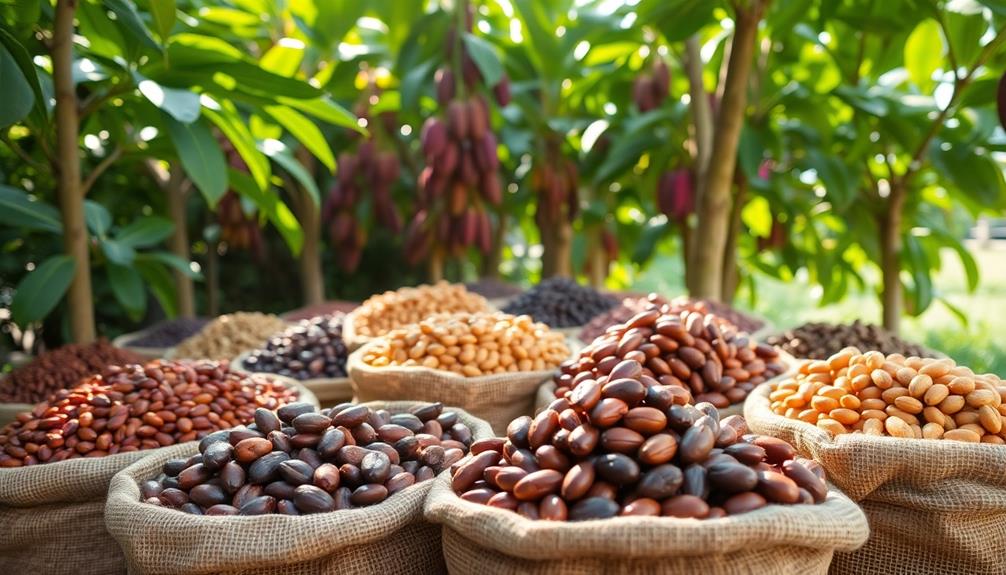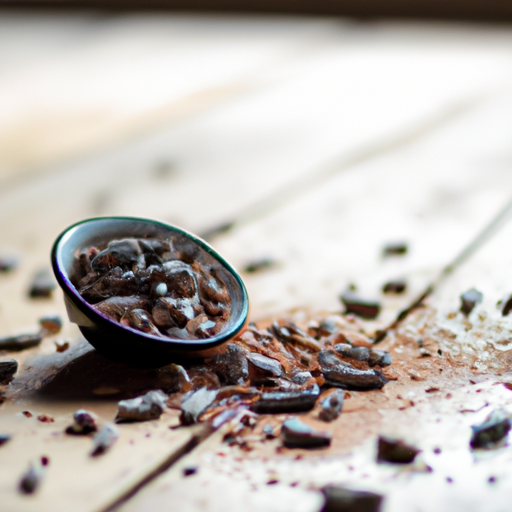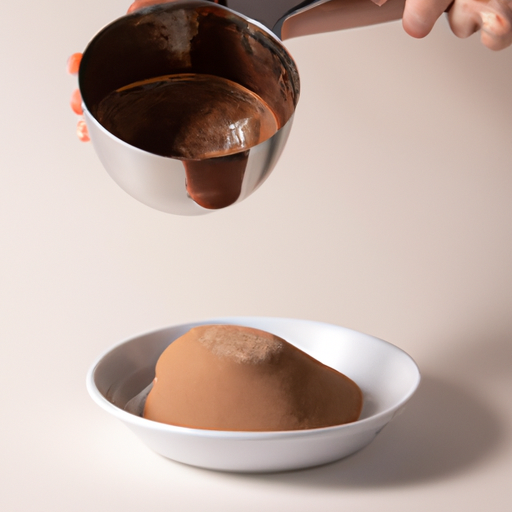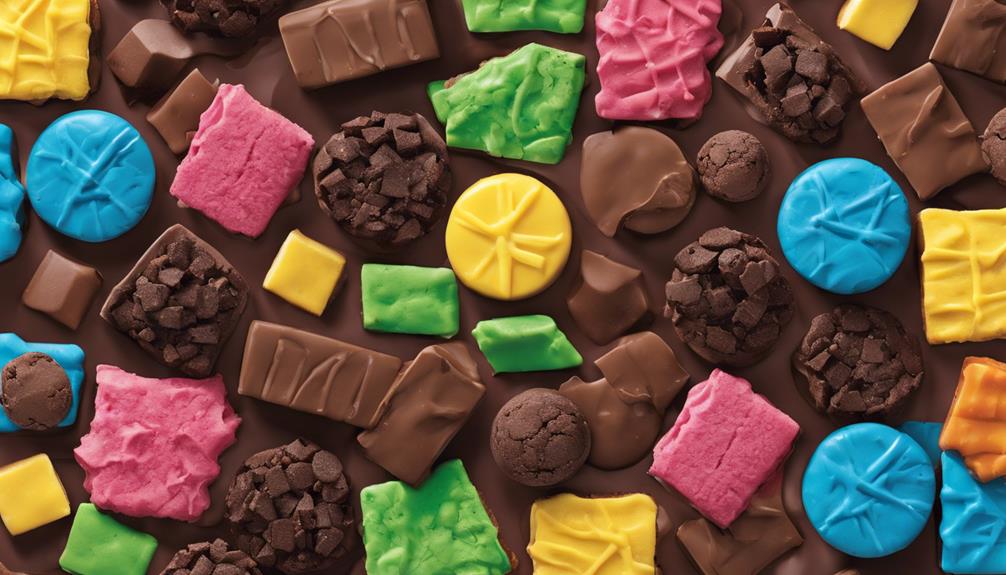When sourcing raw cacao, start by understanding the main varietals: Criollo, Trinitario, and Forastero. Seek out ethically sourced beans, as fair trade practices guarantee quality and support farmers. Evaluate flavor profiles and textures, as they greatly influence your experience; consider brands known for rich, creamy cacao. Pay attention to processing methods, opting for minimally processed options to retain nutrients. Building relationships with farmers enhances quality and sustainability, so prioritize direct trade sources. Selecting the best quality cacao involves a mix of taste, ethics, and mindful sourcing practices. You'll uncover even more tips for sourcing premium cacao.
Key Takeaways
- Assess the cacao varietal; Criollo and Arriba Nacional offer complex flavors, while Forastero is more robust but less nuanced.
- Prioritize suppliers with ethical sourcing practices, ensuring fair trade and sustainable farming methods.
- Evaluate the fermentation and processing methods, as proper techniques enhance flavor and preserve natural compounds.
- Seek certifications such as Fair Trade and Organic to guarantee quality and sustainability in sourcing.
- Build relationships with farmers for direct trade, fostering trust and ensuring high-quality cacao through shared values.
Understanding Cacao Types
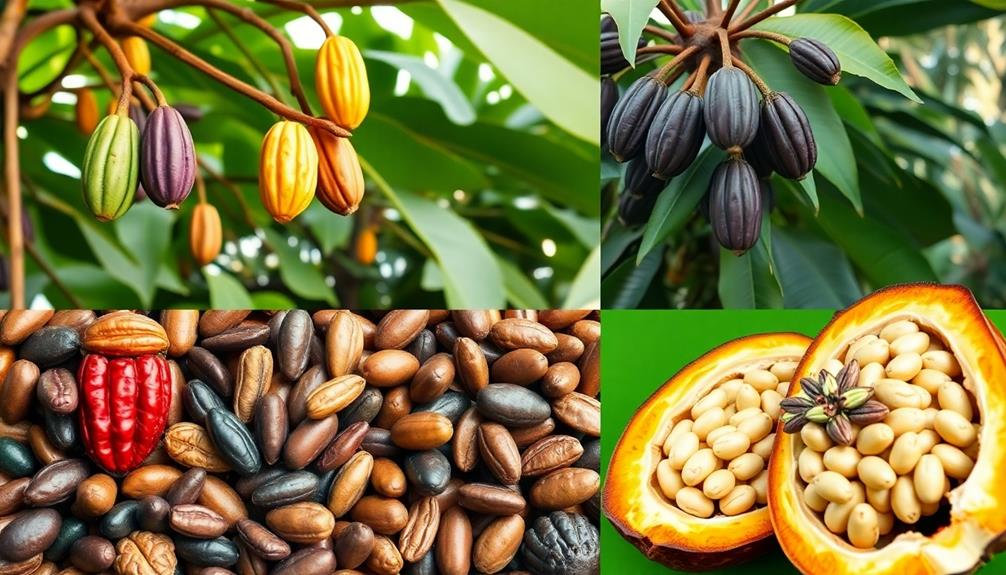
When exploring cacao types, you'll often come across three main varietals: Criollo, Trinitario, and Forastero. Each of these cacao beans has unique characteristics that impact their quality and flavor profile.
Criollo is the rarest and most flavorful, boasting complex taste notes that chocolate lovers cherish. Trinitario, a hybrid of Criollo and Forastero, offers a balance of flavor and resilience, making it a popular choice among premium chocolate makers.
On the other hand, Forastero is the most widely produced variety, known for its robustness and higher yield, but it often lacks the nuanced flavors found in finer cacao beans.
For those seeking high-quality chocolate, the Arriba Nacional variety from Ecuador is particularly significant. Its floral and fruity flavor profile makes it a sought-after ingredient in gourmet products.
The quality of these cacao beans is heavily influenced by post-harvest processing methods like fermentation and drying. These steps are essential for developing the beans' unique flavors, differentiating fine flavor cacao from bulk cacao.
It's important to keep in mind that fine flavor varieties typically come with a higher price tag, reflecting their rarity and the meticulous care required in their production.
Importance of Ethical Sourcing
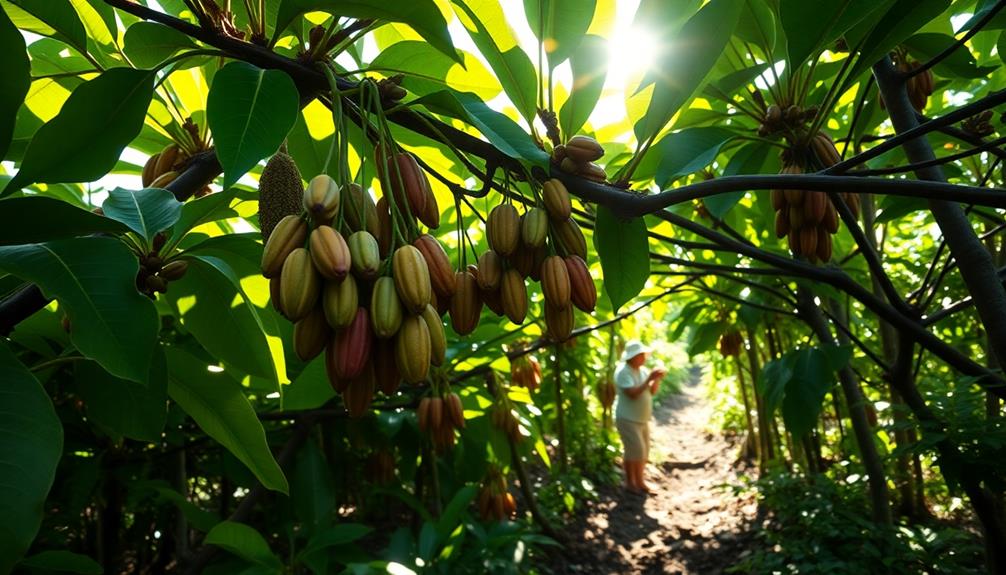
Understanding the types of cacao is just the beginning of appreciating what goes into your chocolate. When you choose ethically sourced cacao, you're not just selecting a product; you're supporting a movement that emphasizes fair trade and sustainable practices. This approach guarantees farmers receive fair compensation for their labor, which enhances their livelihoods and fosters sustainable farming methods.
Many brands prioritize direct trade relationships with farmers, enhancing transparency and accountability throughout the supply chain. By sourcing cacao from women-led cooperatives like Rukux Ulew in Guatemala, you empower marginalized groups and promote gender equality in agriculture.
Ethical sourcing often involves certifications such as Fair Trade and Organic, which help you identify products that adhere to sustainable and equitable practices. When you choose cacao that meets these standards, you're not only investing in the quality of the cacao but also contributing to the preservation of biodiversity and environmental protection.
Responsible farming practices mitigate deforestation and promote soil health, guaranteeing that future generations can enjoy high-quality chocolate. By prioritizing ethical sourcing, you're making a conscious choice that benefits both people and the planet.
Evaluating Flavor Profiles
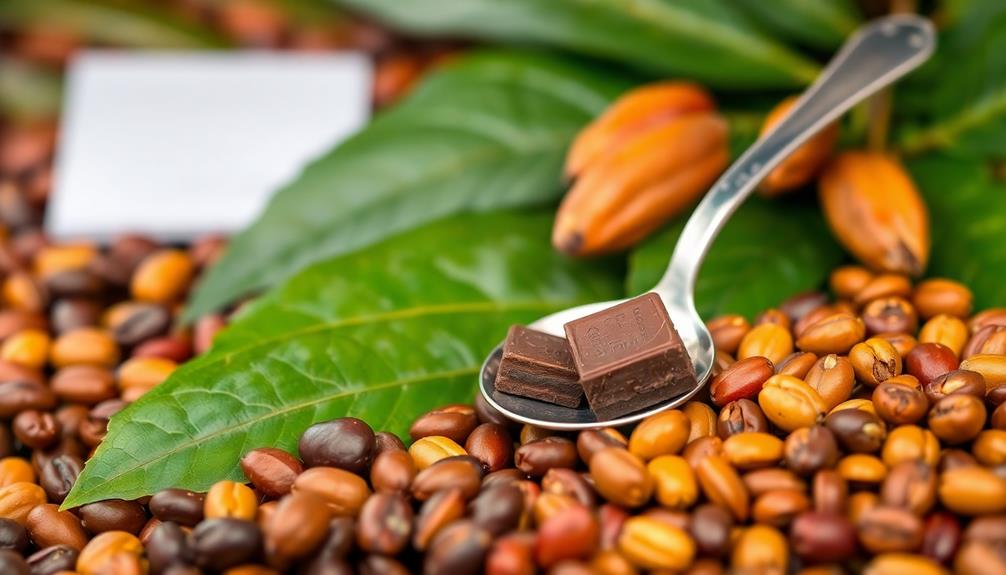
When you evaluate flavor profiles of raw cacao, you'll notice a fascinating range of characteristics, from fruity and floral to rich and bitter.
The texture plays a vital role too; it can transform your tasting experience, adding creaminess or silkiness to the flavors.
Exploring different brands and varieties helps you find the perfect balance that suits your personal taste.
Flavor Characteristics Exploration
How do different brands of cacao create unique flavor profiles? The answer lies in the beans themselves. High-quality cacao varies considerably across brands, leading to diverse tasting experiences.
For instance, Cacao Lab offers a deeply rich and balanced taste, while The Mayan Wisdom Project captivates with a potent chocolate flavor that includes complex notes. If you're looking for something fruity and fragrant, The Cacao Club provides an energizing blend of flavors, enhanced by warming spices—perfect for your morning routine.
As you explore these options, keep in mind that the flavor profiles are influenced by the cacao's origin and how it's sourced. Brands like Vai Cacao and Soul Lift Cacao prioritize ethical relationships with farmers, ensuring that the flavors reflect the unique characteristics of their cacao beans.
This variability means that each batch you try can offer a new experience, making it essential to sample a range of high-quality options. So, immerse yourself in the world of cacao and discover the flavors waiting for you—each brand tells a story through its unique profile.
Texture Impact Assessment
Texture plays an essential role in shaping your overall cacao experience, with its impact on flavor perception being undeniable. The texture of raw cacao can transform how you enjoy chocolate, influencing everything from sweetness to bitterness. Different brands offer unique textures that greatly enhance your experience.
Here's a quick overview of how various textures can affect flavor profiles:
| Brand | Texture Type |
|---|---|
| Cacao Lab | Rich & Creamy |
| Mayan Wisdom Project | Smooth & Thick |
| Cacao Club | Frothy & Silky |
| Custom Selection | Variable |
Cacao Lab's creamy texture balances sweetness and bitterness, making for an indulgent experience. The Mayan Wisdom Project, with its smooth and thick texture, deepens the connection to its complex flavor notes. Meanwhile, the Cacao Club's frothy texture can provide an energizing experience, perfect for morning rituals.
Ultimately, the texture of cacao—from the raw cacao beans in cocoa pods—affects not just flavor, but also your emotional and energetic response. So, when sourcing your cacao, think about how texture can elevate your chocolate journey.
The Sourcing Process
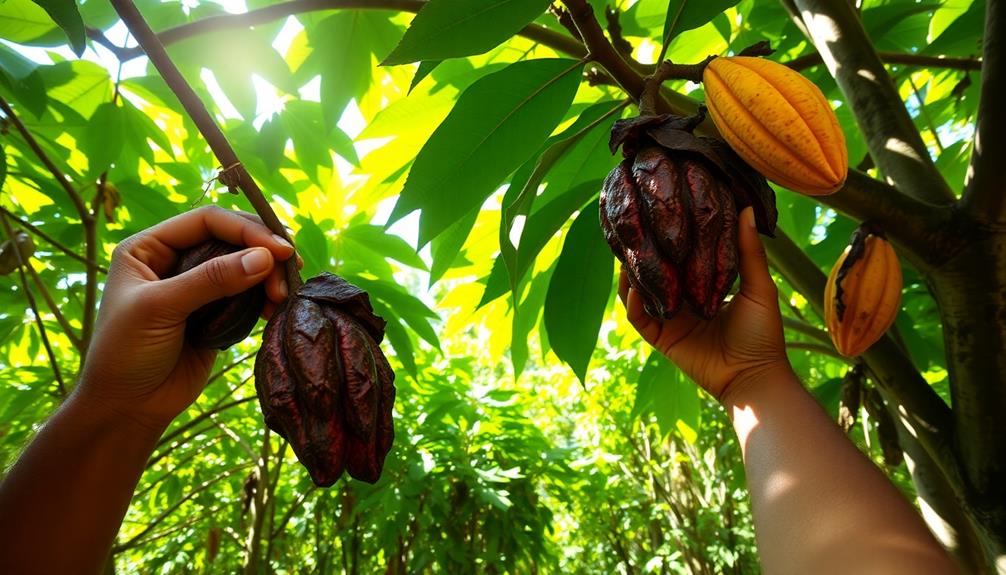
When you're sourcing raw cacao, ethical practices and quality assessment are key.
You need to build strong relationships with farmers, ensuring they follow sustainable methods while meeting your quality standards.
Ethical Sourcing Practices
Ethical sourcing practices play an essential role in the cacao industry, focusing on building direct trade relationships with farmers. By prioritizing these connections, you guarantee that cacao farmers receive fair compensation for their cocoa beans, fostering economic stability in their communities. This approach goes beyond simple transactions; it cultivates transparent supply chains that benefit both producers and consumers.
When you source from specialty cacao farms, you'll want to understand the farmers' cultivation practices and post-harvest processing methods. This knowledge not only enhances flavor quality but also promotes sustainable farming practices. Brands like Soul Lift Cacao and Vai Cacao exemplify this commitment, supporting Indigenous communities and emphasizing ethical sourcing in their operations.
Moreover, engaging in pre-financing systems can provide vital resources for farmers, allowing them to invest in their land and practices. Training in harvesting and fermentation techniques further elevates the quality of the cacao you source.
Establishing long-term partnerships with farmers and cooperatives creates resilience in the cacao supply chain, as shared values in sustainability and quality are nurtured over time. This conscious approach to sourcing ultimately leads to a richer, more responsible cacao experience.
Quality Assessment Criteria
Evaluating the quality of raw cacao involves a meticulous evaluation of several key factors that directly impact flavor and overall quality.
First, assess the fermentation process. Properly fermented beans enhance flavor and aroma, while poorly fermented ones can lead to undesirable tastes.
Next, examine the varietals of cacao. Fine flavor types like Criollo and Trinitario generally offer superior quality compared to bulk varieties, which may have mixed fermentation levels.
Consider the sourcing location as well. Regions known for high-quality cacao, such as Ecuador and Grenada, often produce beans with distinct flavor characteristics and higher market value.
Additionally, review the processing methods used by suppliers. Look for raw cacao that's minimally processed to retain its natural compounds and nutrients, as extensive processing can compromise quality.
Lastly, confirm ethical sourcing practices. A transparent supply chain and direct trade relationships usually yield higher quality cacao, as farmers are likely to give better care and attention to their beans.
Building Relationships With Farmers
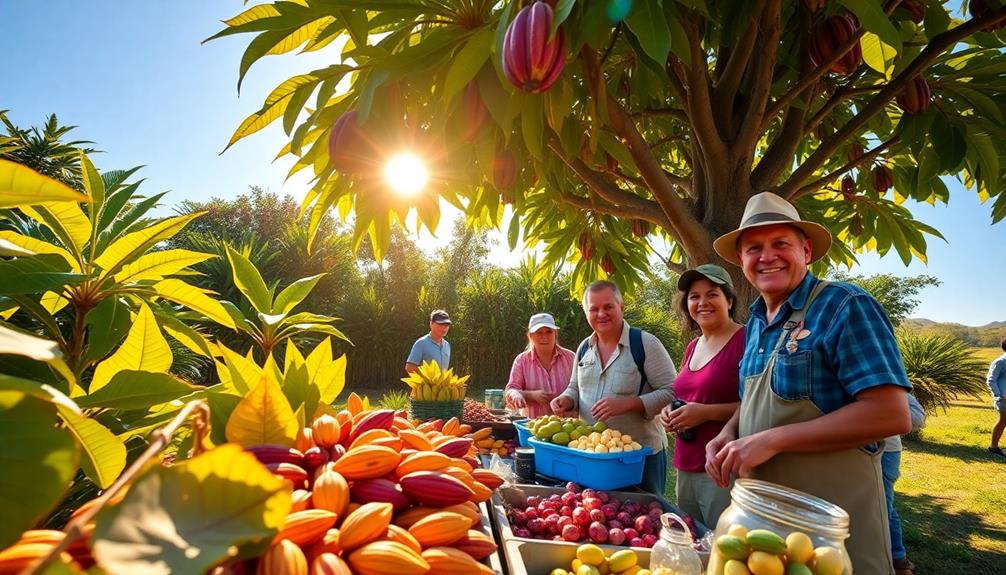
Building strong relationships with cacao farmers is essential for sourcing high-quality raw cacao. When you engage in direct communication and collaboration with farmers, you gain deeper insights into their practices and challenges. This understanding allows you to appreciate the unique qualities of the cocoa they produce.
To foster trust and motivation, invest time in these partnerships. When farmers feel valued, they're more likely to share their best harvests. Participating in farmer training programs can further enhance their skills in harvesting and fermentation, leading to improved cacao quality.
Here's a simple overview of the relationship-building aspects:
| Aspect | Benefit |
|---|---|
| Direct Communication | Understand farmer challenges |
| Trust Investment | Better quality cacao |
| Training Participation | Enhanced harvesting skills |
| Fair Compensation Agreements | Supports livelihoods and quality |
| Feedback Loops | Adapt sourcing to evolving needs |
Cacao's Impact on Wellbeing
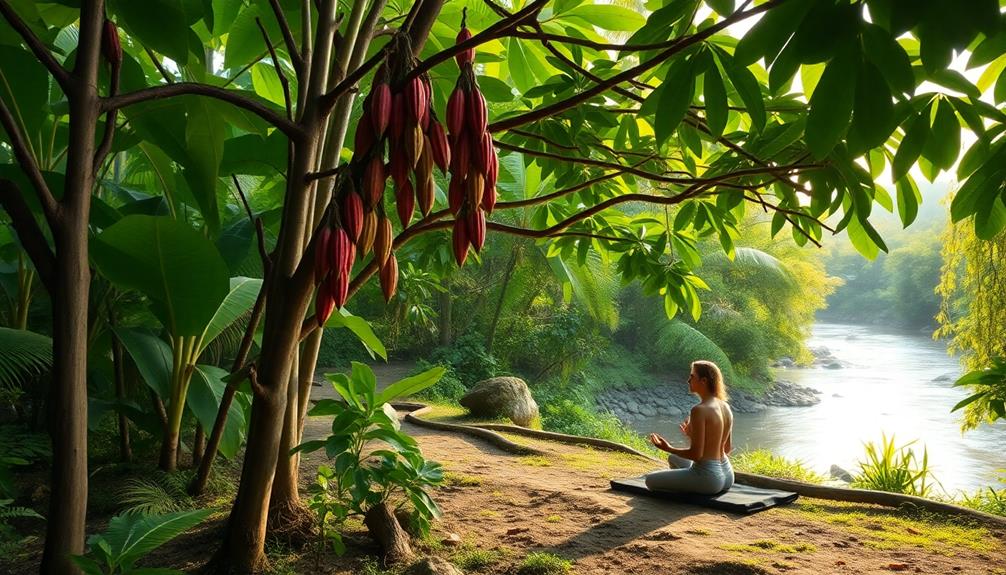
Cacao's rich compounds can considerably enhance your overall wellbeing, promoting feelings of joy and openness. When you consume high-quality cacao paste, you're not just indulging in a treat; you're also reaping numerous health benefits. Its high concentration of antioxidants, especially flavonoids, can improve mood and cognitive function, helping you feel mentally sharp and focused.
Participating in cacao ceremonies can further deepen your experience. You might find that these rituals foster community bonds and spiritual connections, enhancing emotional health. Many people report stable energy levels from cacao, without the jitters often tied to caffeine, allowing for a sense of calm and mindfulness.
Here are a few key health benefits of cacao:
- Enhanced emotional wellbeing through the promotion of joy and openness.
- Improved cardiovascular health, thanks to essential minerals found in cacao.
- Increased emotional resilience, supporting your overall mental health.
Chocolate makers who prioritize quality cacao can help you find products that truly support your wellbeing. By choosing the right cacao, you're not just treating yourself; you're investing in your health and happiness.
Frequently Asked Questions
How Do You Pick a Good Cacao?
When you pick good cacao, look for high-quality varietals like Criollo or Trinitario. Check for minimal processing, ethical certifications, and verify the origin to guarantee you're getting the best flavor and benefits possible.
What Is the Highest Quality Cacao?
Did you know high-quality cacao can cost 5-10 times more than bulk varieties? The best cacao comes from fine flavor types like Criollo and Trinitario, known for their unique flavors and lower yields.
How Do I Choose the Best Cacao Powder?
When you choose cacao powder, focus on the type, check for ethical certifications, and guarantee it's 100% cocoa. Higher-quality options often come from fine varietals, enhancing flavor. Store it properly for longevity.
How Do You Know if Cocoa Powder Is Good Quality?
To determine if cocoa powder's good quality, check for "100% cocoa" labeling, assess its color, look for certifications, guarantee freshness, and evaluate taste and aroma. A rich flavor and pleasant scent indicate quality.
Conclusion
In choosing high-quality raw cacao, remember that your decisions can make a real difference. Did you know that around 70% of the world's cacao is produced by smallholder farmers? By supporting ethical sourcing and building relationships with these farmers, you're not just enhancing your chocolate experience; you're also contributing to their livelihoods and promoting sustainable practices. So, next time you indulge, think about the journey your cacao has taken and the impact your choice can make.

